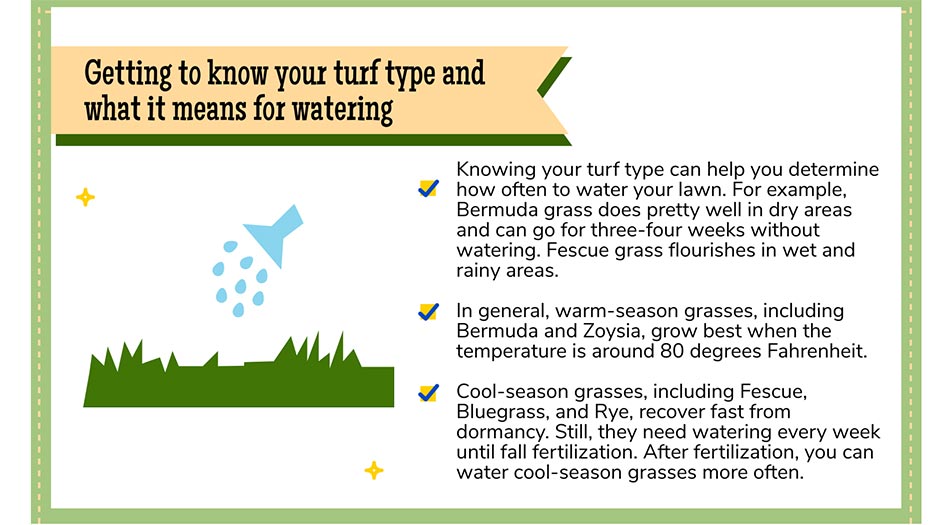Watering your lawn may seem like a simple process, but in practice, it is something you need to take note of. The difference between a green and healthy lawn and a dry one has to do with how often you water your turf.
In this article, we will explain everything you need to know to get the best results for established grasses and newly seeded grasses. With professional guidance and close attention, you will have a good-looking yard in no time.
Too much water is not the best option. Too little water is not good as well. Finding the perfect balance is the key to having a beautiful lawn. Whether you have established or newly seeded grass, there are several considerations to make when watering your turf. These include the type of grass, the time of day you water, and how long you water.
We live in a world with varying seasons. It is impossible to disclose a rule like – water your lawn three times a day for 30 minutes. What if your grass doesn’t need much water? What if you are located in a relatively rainy area? Don’t bother looking for a precise formula that works in every location or on all turf types because you won’t find any. Hopefully, by explaining the watering process and what is right and wrong, you will be able to determine how often to water your lawn to get the best results.
Knowing your turf type can help you determine how often to water your lawn. For example, Bermuda grass does pretty well in dry areas and can go for three-four weeks without watering. Fescue grass flourishes in wet and rainy areas. They can also be drought-resistant due to their rooting systems and don’t require watering often.
New grass seed, on the other hand, requires regular watering to grow and become established. However, make sure not to over-water because you can kill your new sod. Proper watering is essential because it helps the roots to extend far into the ground.
In general, warm-season grasses, including Bermuda and Zoysia, grow best when the temperature is around 80 degrees Fahrenheit. Continue to water them as long as the turf is growing. Cool-season grasses, including Fescue, Bluegrass, and Rye, recover fast from dormancy. Still, they need watering every week until fall fertilization. After fertilization, you can water cool-season grasses more often.
Local weather plays a vital role in how often to water your turf. In general, most lawns sprout with one inch of water per week. If you are experiencing a lot of rain soon, you may skip your watering ritual. If you are in a hot and dry area, it is better if you water more often (for example, twice a week).
If temperatures in your area are above 90 degrees and below 40 degrees Fahrenheit, turf can become dormant. Watering your lawn in temperatures like these won’t change anything regarding the lawn’s moisture. It is better if you wait for the temperatures to cool down or warm-up.
The time of day you water your lawn is another factor to consider. You don’t want the water to dry up, so the best time to water your turf is in the morning (especially if you have newly seeded grass). Watering in the morning hours, when the sun is out, but there is no wind yet is best because you will avoid water evaporation and allow your grass to absorb the right amount of water to feed the seeds.
If you are not available to water in the morning (between 6-10 am) because of your daily responsibilities, late afternoon is also an acceptable option.
Once your grass grows bigger, you can stop watering as frequently, and water every two or three days. The turf’s soil shouldn’t be dry, nor too damp because lawn diseases may show up.
The ideal combination is to water less frequently but more deeply. By doing so, you will encourage your grass to develop stronger roots. Once your grass is more than three inches, you can water less often, but deep as four inches.
Shallow watering is not effective and may lead to lawn diseases, lawn damages, and insect infestations. The ideal watering schedule is once or twice a week (depending on the type of grass) for 20-30 minutes.
Knowing when it is time to water your lawn is essential for having a green lawn. A turf that has dried out may fall dormant or turn a brown or yellowish shade of greed. Some grasses will even bow when they are in desperate need of watering.
The best way to determine whether it is time to water your lawn is to check the turf’s moisture. One of the simplest techniques is using a screwdriver – shove your tool straight down into the ground. If you have trouble getting your tool deep down (around 6 inches) into the ground, chances are your lawn is dry and requires immediate watering.
Sprinklers are one of the most effective watering systems without wasting excessive water. There are different types of sprinklers, but pulsating and oscillating are two of the most common ones.
Which one is better on a small lawn? Which is more suitable for an established grass and which for newly seeded grass?
Like most lawn owners, you probably wonder which one will help you distribute water across the yard and keep your turf hydrated at all times.
Pulsating sprinklers are recommended for mature grass, while the oscillating sprinklers are better for new lawns.
Pulsating sprinklers have a more intense stream and may wash away the new seeds. If you have an established grass, this type of sprinkler is the ideal choice. However, if your lawn is relatively new, oscillating is a gentler option because the water stream is softer and can’t harm the seeds. If you’ve just planted the seeds, water for 15-20 minutes every day for two weeks. After that, you can water every two days until the seeds develop stronger roots.
Too much water is bad for established grasses and newly seeded grasses alike. It can result in mold and rot growing, especially if you live in a wet and cool area. Overwatering grass can also drown roots and lead to your lawn dying.
From a professional point of view, under watering is less harmful than overwatering because most grass types are resilient and can sustain under-watering. Your turf will find a way to tell you when it needs watering.
Every lawn is different, so consider how moisturized your soil is, how warm it is outside, and what type of grass you have.
Taking care of your lawn doesn’t have to be a demanding or an all-consuming task. Follow our tips, and before you know it, you will come up with the right watering routine that will result in a green and beautiful lawn.







